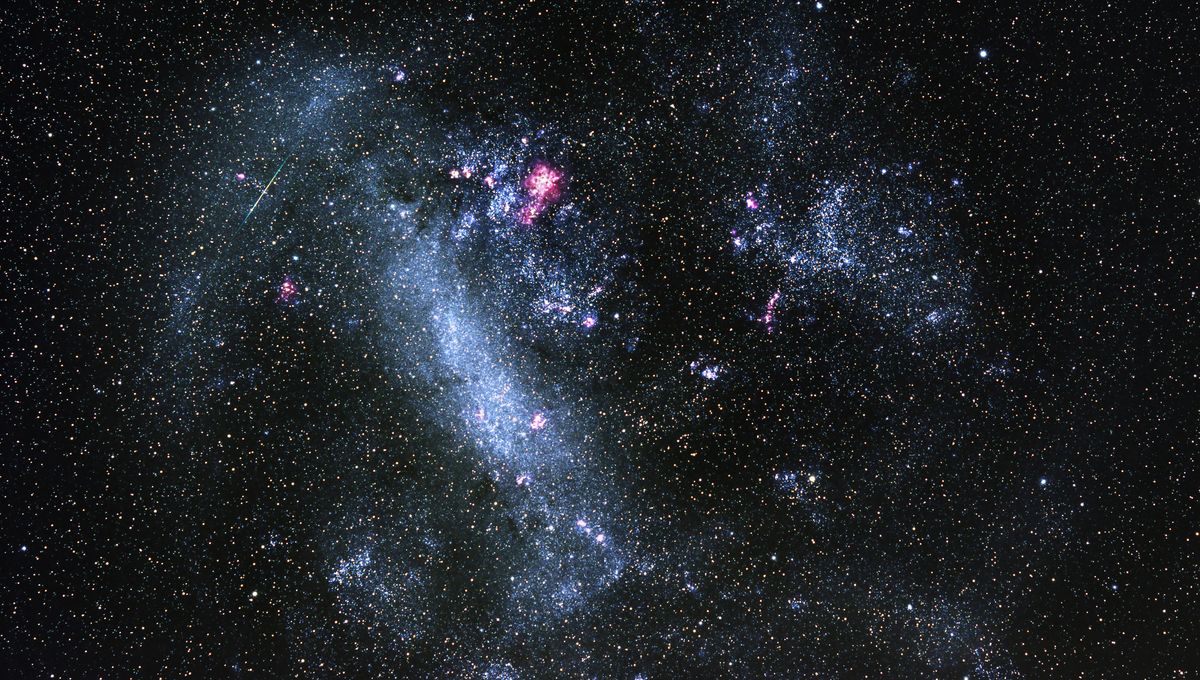
Some fast-moving stars within the Milky Way have been traced back to the Large Magellanic Cloud (LMC). In a preprint paper that has not yet completed peer review, the astronomers who demonstrated these stars’ origin consider them evidence for the presence of a supermassive black hole within the nearby galaxy, whose gravity is accelerating the stars to speeds that will see them escape both galaxies.
ADVERTISEMENT GO AD FREE
Most stars circle the galaxy at a stately pace, but some shoot through the Milky Way at very high speeds. These are known as hypervelocity stars (HVSs). Those moving so rapidly, particularly in the galactic halo, that they will eventually escape it entirely are known as unbound HVSs. They are thought to either be companions of supernovae, given an enormous kick when the star they were close to exploded; or products of disruption by the supermassive black hole (SMBH) at the galaxy’s heart.
In 2006, a survey of the galactic halo found 21 unbound B-type (the second most massive star category) HVSs. The group has puzzled astronomers ever since, particularly the question of why 11 of them are in just 5 percent of the sky near Leo.
However, when a team of researchers traced the paths of these stars back, allowing for the influence of gravitational fields they have encountered, they found something extraordinary. “Half of the unbound HVSs discovered by the HVS Survey trace back not the Galactic Center, but to the LMC,” the authors write. The idea some HVSs come from companion galaxies is not new, but no one expected it to be this common.
The LMC produces a lot of very large stars of the kind that become supernovae – the last supernova visible to the naked eye was in the LMC, not our own galaxy. However, while supernovae are good at producing small HVSs, they can’t make B-type stars travel all that fast, making it unlikely that’s the mechanism behind the stars in this survey.
The team created a model of likely HVSs if they were accelerated by an SMBH through what is known as the Hills mechanism. This involves two stars in close orbits approaching an SMBH, with one becoming captured while the other is ejected very fast. It’s like if someone devilishly attractive decides to break up a couple so they can secure one partner for themselves.
The team’s results on both speed and path proved; “Remarkably similar to the observed distributions,” the authors write.
ADVERTISEMENT GO AD FREE
The LMC is in orbit around the Milky Way, and that orbital velocity is added to anything the SMBH applies, producing a clustering of HVSs around Leo from our perspective, just as had previously been found. Of the 21 unbound B-type stars, the authors say 9 probably or definitely came from the LMC, 7 from the Galactic Center, with the source of five not being identified with confidence.
The authors conclude the LMC’s SMBH should have a mass about 600,000 times that of the Sun to produce so many B-type HVSs. That’s modest compared to Sagittarius A*’s 4,300,000 solar masses, but larger than past estimates for a small galaxy like the LMC, some of which have been as low as 1,000 solar masses.
All large galaxies are thought to contain SMBHs, but astronomers have been less certain whether that extends to dwarf galaxies like the Magellanic Clouds (or whatever we choose to call them). These findings could influence that.
The Milky Way can be seen as something of a bully, having devoured many smaller galaxies to achieve its vast mass, and partially ripped survivors like the Magellanic Clouds apart. However, it seems the LMC is one smaller galaxy that doesn’t take this kind of mistreatment lying down.
ADVERTISEMENT GO AD FREE
The study has been submitted to the Astrophysical Journal, currently available as a preprint on ArXiv.org.
[H/T Universe Today]
Source Link: A Black Hole May Be Firing Fast Stars At Us From The Large Magellanic Cloud